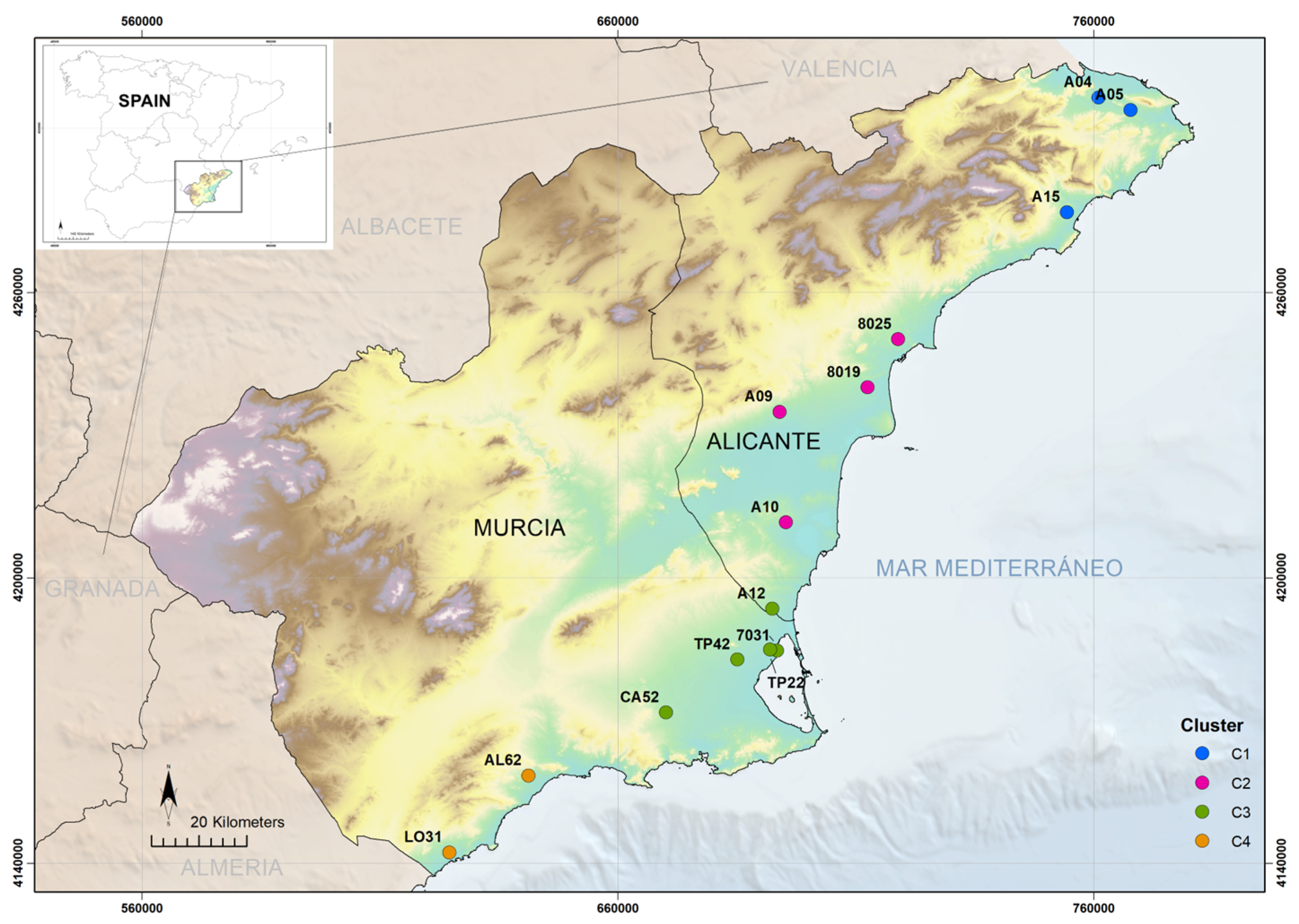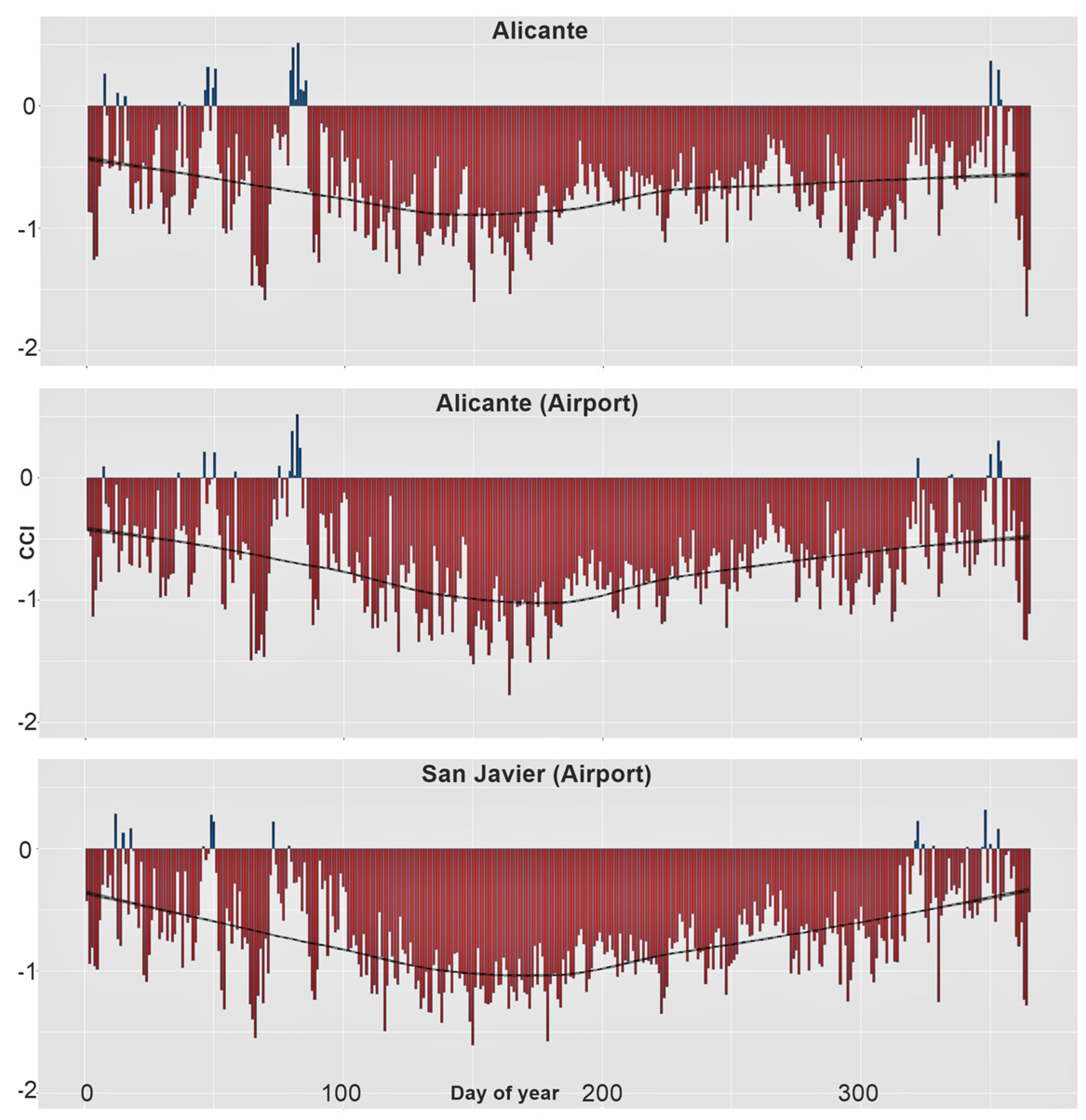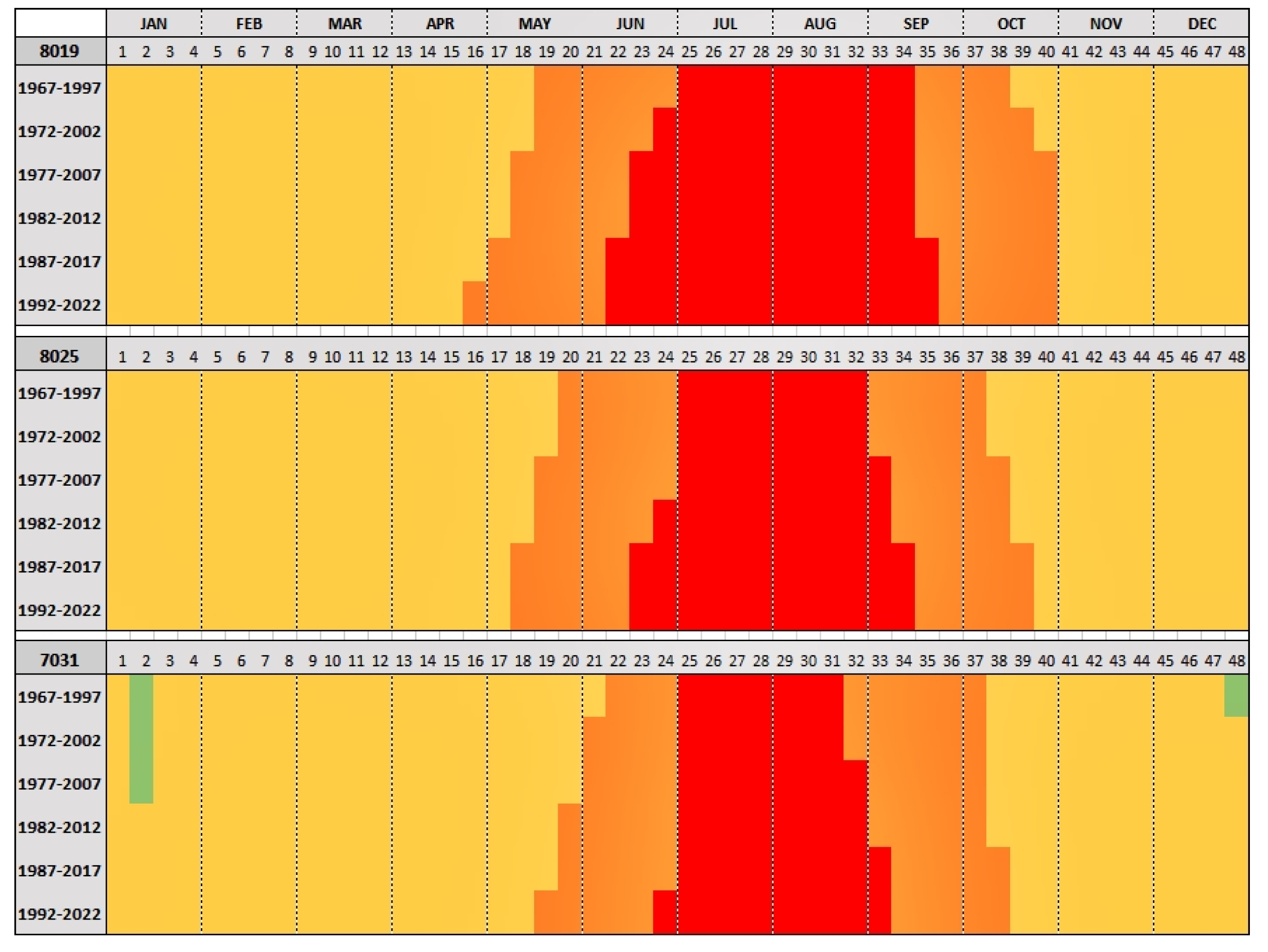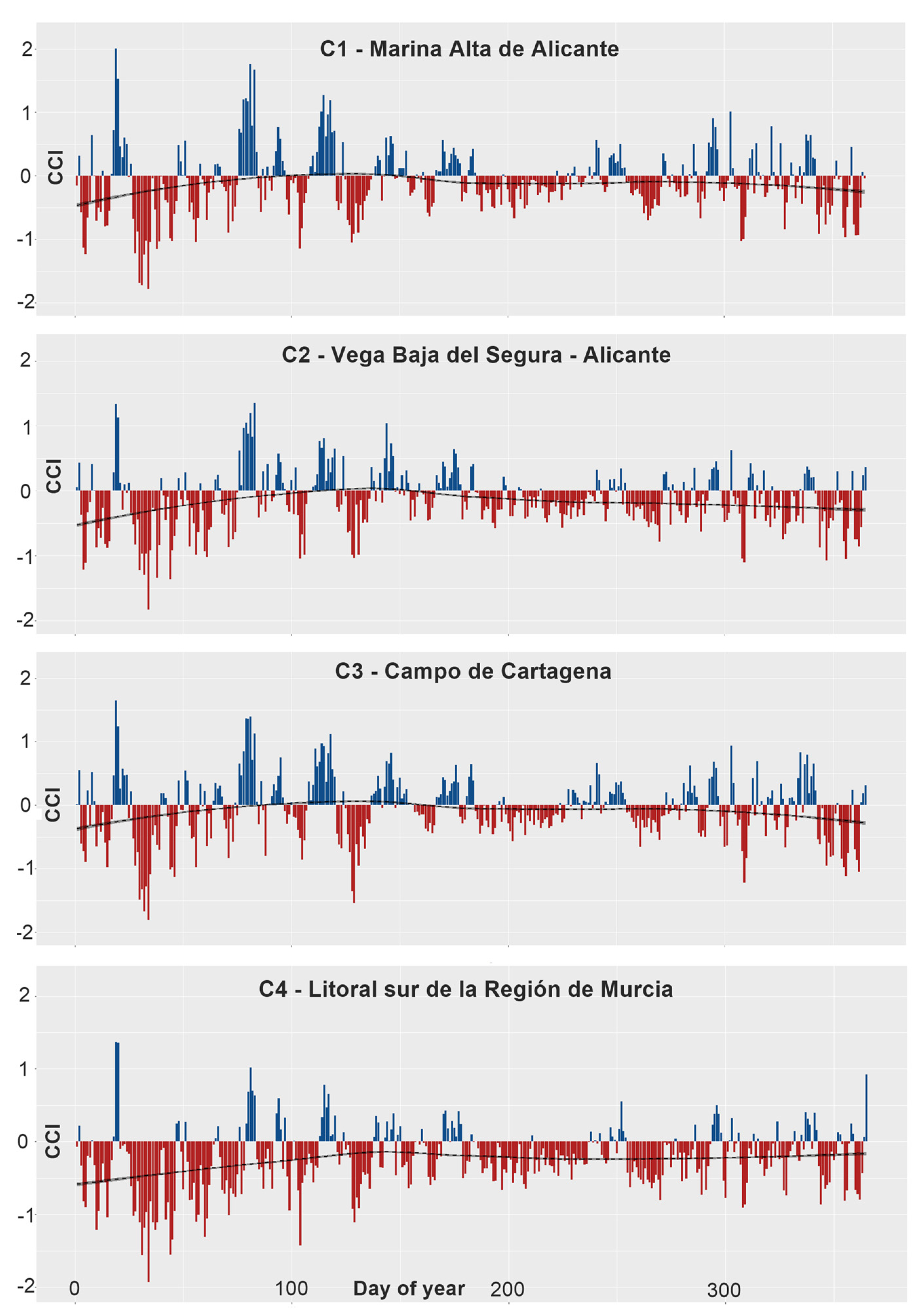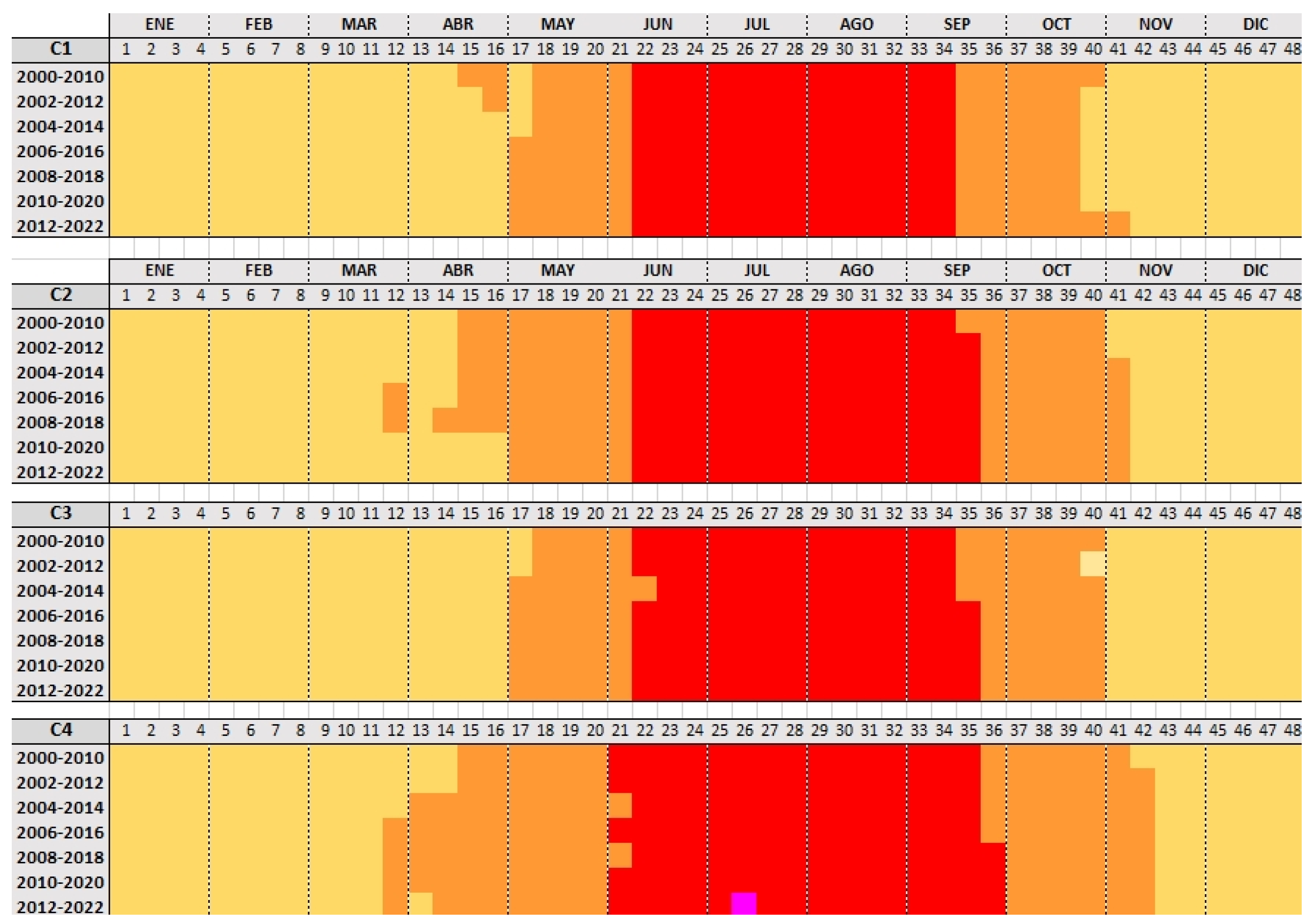1. Introduction
Bioclimatology has been extensively developed in recent years due to the close relationship existing between climate, health and certain economic activities related to the human enjoyment of the outdoors, such as tourism. With respect to this sector, a lot of research has been carried out to analyse the development of bioclimatic comfort and its relationship with suitability for tourism. Some studies provide necessary information on the perception of external microclimatic conditions in a coastal environment and differentiate tourists from everyday users of urban spaces [
1]. Furthermore, Lopes et al. (2021) conclude that the influence of microclimatic conditions on the thermal comfort of tourists was evident [
2]. It is a concept which, despite its usefulness in the current context of climate change, has not been sufficiently managed in urban planning, particularly with the recent intensification of heat islands in large urban nuclei and the impact of extreme events related to high temperatures in the city.
On the other hand, studies have been conducted that apply comfort indices to tourism activity, due to its high degree of exposure to climate conditions and the high share of Growth Domestic Product (GDP) that it represents in the regions and destinations that develop this economic activity. Hence, the effect that the current climate change process could have on the future evolution of tourism activity, particularly the sun and beach model, is concerning. Therefore, in recent years, the comfort conditions in different parts of the world with a clear tourism vocation or significant tourism potential have been analysed so as to be used in planning and decision-making at different scales. From the 1970s, coinciding with a moment of accelerated economic growth in many western economies and with the development of the first tourism wave after the Second World War [
3], the field of study of tourism climatology was developed, and since its establishment, has evolved, addressing the climate–tourism binomial in the 1990s, and currently analysing the factors that limit the practice of tourism [
4,
5,
6]. Thermal comfort has been the object of many studies in recent years within the context of global thermal warming [
7,
8]. In this respect, different studies have confirmed the loss of thermal comfort recorded due to the considerable increase in “tropical nights” over the last few decades in different regions of the world, with a notable incidence in the coastal areas of the Mediterranean basin, related to the warming of seawater [
9].
In order to assess the impact of climate variables on the human organism, the concept of thermal comfort was developed [
10], defined by the environmental conditions (air humidity, wind speed, radiation and temperature) that maintain the losses and gains of the human organism to achieve the minimum thermoregulatory balance, without cold or heat stress [
11,
12]. In the 1970s some cold indices emerged [
13]. Subsequently, so-called “comfort indices” appeared, classified as quantitative, qualitative and hybrid [
14]. Initially, the quantitative indices were based on theoretical models to calculate the thermal balance of a person, including, among others, the comfort index [
15].
Currently, thermal comfort is defined from an international point of view using the ISO 2005 or ANSI/ASHRAE [
16], which, in addition to physical or physiological factors, establishes psychological or emotional factors as part of cold or heat sensations, that is, subjective perceptions that form part of the cognitive process. This idea has led to many debates in the scientific community in order to arrive at a consensus in defining human thermal comfort, although currently efforts are complex due to the component of human perception [
17].
Over the last few years, several bioclimatic indices and climate–tourism indices have been consolidated to quantify thermal sensations and define comfort thresholds. They are widely used today and have provided a basis for more recent comfort indices. They include the apparent temperature index [
18], the equivalent temperature index [
19], the Universal Thermal Climate Index (UTCI) [
20] and the comfort index (CI) [
21]. Furthermore, recent studies have shown discrepancies between the predictions of the indices and predicted and real thermal sensations [
22]. Today, studies prefer to estimate the thermal sensation using thermophysiological indices such as the Physiological Equivalent Temperature (PET) and the UTCI [
23,
24].
The current context of change and global warming forebodes a greater frequency of hot days throughout the year, giving rise to increasingly severe summers in tropical and sub-tropical countries, leading to a loss of thermal comfort for visitors [
25]. This aspect could be particularly relevant in a city climate, where bioclimatic urbanism is attempting to adapt to these new realities [
26].
The most recent studies have been carried out in different cities around the world, focusing mainly on the thermal perception of the local residents and foreign visitors [
27], where acclimatisation leads to differences in thermal perception in several climate zones [
28,
29,
30]. Lin conducted an analysis in the city of Taichung (Taiwan), finding that the acceptable thermal range is greater than in European cities [
31]. Therefore, foreign visitors experience different climate perceptions from residents. This is a fundamental aspect in the climate planning of tourism [
25].
The perceived control defined by Nikolopoulou and Lykoudis concludes that people with a greater freedom of movement in hot conditions have greater thermal satisfaction than those with stricter timetables and a low level of autonomy [
32,
33]. Thorsson et al. find that with a higher level of thermal comfort, tourists remain outdoors for longer [
34]. Analyses have been carried out in several thermal studies for different cities, mainly in Europe [
35,
36], and have generated interesting conclusions. In Australia (Sydney), no differences were found with respect to gender in the perception of heat [
37]. Kenawy and Elkadi affirmed that the inhabitants of America, north-east Europe and Australia had a higher average thermal sensation than Asian inhabitants in the summer, which implies that this latter group had greater difficulty withstanding the heat [
38].
Pantavou evaluated the performance of a large number of thermal indices to quantify the thermal sensation in the area of Athens (Greece) [
39]. The ASV index, the subjective temperature index (STI) and the universal thermal climate index (UTCI), based on calibrated scales, better predicted the thermal sensation compared to the rest of the indices studied.
Picone and Campo analysed the regional conditions in Tandil (Argentina) using three summer indices and one winter index, finding that cities with a warm climate generate less comfort in the summer than in the winter [
40]. The following year, the seasonal characteristics of the tourist flow were analysed using the Temperature-Humidity Index (THI) using data from Weather Underground’s network of personal weather stations [
41].
In Spain, studies analysed the thermal evolution in Barcelona are noteworthy [
42,
43] due to the importance of the size of cities in local changes in temperatures [
44,
45] and their negative effects on mortality during hot nights [
46]. These studies draw from the classical contributions of the concept of “heat islands” developed in this field [
47,
48].
There are different indices for the study of thermal comfort, such as the effective temperature index, the Hill index, the bioclimatic diagrams of Olgyay and Givoni and the PMV and PPD indexes, which are adapted for different research objectives: human comfort and urban and building design [
10,
49]. Due to the availability of climate data with a high spatial resolution, some studies use the Climate Comfort Index of Mieczkowski to assess the current situation and make forecasts until the end of the century [
50]. The use of this index has been tested in previous studies with adequate results and has been shown to be ideal for tourist suitability estimates for a territory [
51,
52].
In recent years, the climate–tourism index (ICTI) proposed by Mieczkowski has been used for the interior of the Iberian Peninsula (Madrid) and the province of Alicante in order to confirm the possibilities and limitations for evaluating climate and its influence on this type of tourism and the climate–tourist aptitude for future decades [
51]. In the field of the impact of climate change on tourist destinations (region of Valencia), the Mieczkowski index has been modelled to analyse the modifications predicted until the end of this century, with a view to develop measures for the adaptation of tourism activity [
53,
54]. Meanwhile, within the framework of climate change regulations (state and regional), plans have been developed for adapting to climate change in tourist destinations that include the analysis of thermal comfort and the future projection of comfort indices [
55].
The most recent studies on climate comfort have been developed in Andalusia (Spain), applying the discomfort index of Thom [
56] and the associated weather types to the eight provincial capitals [
57]. Moreover, Colón Lasierra analyses the climate comfort in the Spanish peninsula and its coast–inland variations, also using Thom’s discomfort index. This study generates daily calendars of the probability of surpassing certain discomfort thresholds in the different observatories [
58].
The objective of this research is to analyse climate comfort in the territory of the southeast of the Iberian Peninsula. The conclusions will be relevant in the scientific community to address future tourism planning on the coast of SE Spain. The policies applied during the coming years must take into account the changes experienced in thermal comfort in recent decades, and especially during the last few years in a region with great tourist pressure in summer. To this end, previous studies on the subject conducted for the chosen area of study have been analysed and, based on the knowledge of the evidence of climate change recorded in the Spanish Mediterranean region, the following objectives have been established: to conduct a comparative analysis of different climatic comfort indices in order to evaluate the results and the suitability of their application to the study area; to study the recent evolution of climatic comfort indicators in the context of climate warming, highlighting the loss of comfort produced in recent decades; to also evaluate the temporal evolution of climatic comfort in the areas analysed throughout the year, with a view to the future establishment of more favorable tourist seasons; to use two different time periods, a longer-term one (1967–2023) with the aim of identifying the changes occurring in recent decades and a more recent one (2000–2022), analysing the most recent changes with a greater density of meteorological stations used and finally, to verify the data used via quality controls, particularly according to less used climatic elements (wind speed, relative humidity and solar radiation).
4. Conclusions
The research aimed to analyse and corroborate the increasingly warmer thermal conditions on the southeastern coast of Spain, especially in summer. The following conclusions were drawn, highlighting the notable increase in thermal discomfort in the study area.
On the coast of the provinces of Murcia and Alicante, the “heat” threshold is reached but not the “excessive heat” threshold (1967–2023). However, in the most recent time period (2012–2022), the threshold of the greatest discomfort due to heat was reached for the first time in the second week of July within the southern coast cluster of the region of Murcia. The greatest losses of comfort in the CCI index (1967–2022) occurred between mid-April and the first week of July, constituting an advance in time of 3 weeks for the “heat” threshold. Furthermore, over the last few decades, there has been an increase of 38.7 days throughout the year. In the period 1967–2022, there was a statistically significant decrease in the CCI in every month of the year, particularly May and June (−0.3 to −0.4/decade). During these months, the greatest (statistically significant) increase in the average temperature occurred (0.5 to 0.7 °C/decade), together with the greatest reduction in relative humidity (−1.0 to −2.1%/decade) and wind speed (−0.2 to −0.9 km/h).
In the most recent time period (2000–2022), the greatest decreases in the CCI occurred in the winter quarter (DJF), specifically between the second week of December and the second week of February, obtaining less cold and more comfortable thresholds. In the summer quarter (JJA), the changes have not been so significant in the last few years (2000–2022). Even so, in barely 22 years, statistically significant decreases have occurred in July and September in the regions C2 and C4 (−0.2 to −0.4/decade), reaching “excessive heat” thresholds for the first time. This is principally due to the statistically significant increase in the average temperature between July and September (0.4 to 0.7 °C/decade) and to the reduction (also statistically significant) in wind speed (−0.3 to −0.9 km/h/decade). Therefore, there has been an average increase of 8.5 days on which the “heat” threshold was reached throughout the year.
The research now opens to a broader analysis, including the rest of Spain’s coastline (and the two archipelagos of the Canary Islands and the Balearic Islands). A future line of research would work with data from the ERA-5 reanalysis of the Copernicus Project (1940–2022), mainly due to the limitation of surface observational data (very limited daily meteorological series for the decades of the 50s, 60s and 70s). This type of tourism based on visiting beaches, museums, shows, family attractions, parks and gardens, old towns, shopping, gastronomy on terraces, nightlife, etc. delimits tourism by activity schedules. Introducing a time scale will allow planning, taking into account the climate–tourism time suitability based on comfort scenarios, extending or reducing tourist days.
